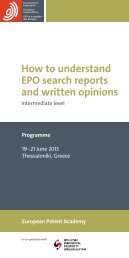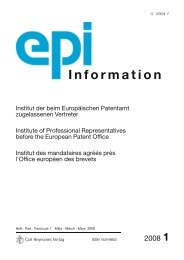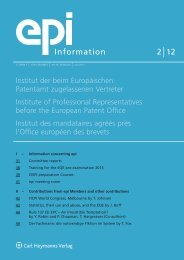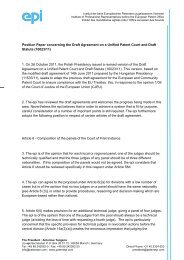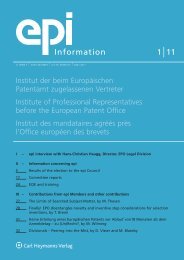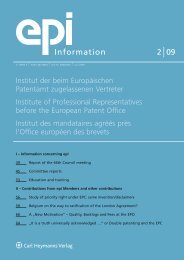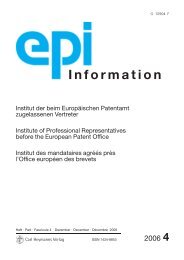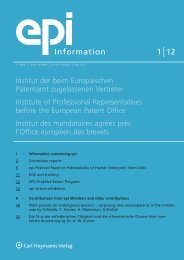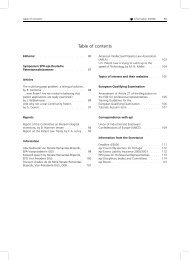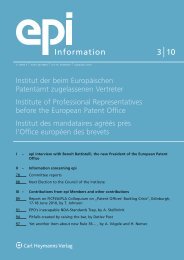128 Articles <strong>Information</strong> 4/<strong>2010</strong>reference to a Euro-PCT application filed with the USPTOas receiving Office, the applicant must file a certified copyof the Euro-PCT application with the EPO.It should be noted that the period of more than fourmonths to file a copy of the previously filed applicationmay be too short for procuring a certified copy from somepatent offices. To avoid losing the date of filing, it isrecommended to file by reference only when the applicanthas the certified copy available on the date of filingor when the EPO will include the copy into the file. Anapplicant may even consider using filing by reference onlywhen the EPO will include a copy of the previously filedapplication into the file, because the advantage of filingby reference may not outweigh the expense andadditional risk of having to file a certified copy.Rule 40(3) EPC contains the additional requirementthat the applicant must file a translation of the previouslyfiled application where that application is not in anofficial language of the EPO. This requirement correspondsto item (iv) above.Although both the filing of the copy and the translationof the previously filed application are mentioned in onesentence of the optional requirement in Rule 2(5)(b) PLT[see item (iv) above], the EPO has decided to treat theserequirements differently. 19 Whereas the EPO has madethe filing of the copy compulsory for the accordance ofthe date of filing, the filing of the translation is consideredas an issue of formalities. In spite of the fact that the filingof the translation is mentioned in Rule 40 EPC, titled„Date of filing“, it is not regarded as a filing date requirement,because Rule 55 EPC does not refer to it. 20 Thisinterpretation can be derived from the Guidelines. 21Hence, if the applicant does not furnish a requiredtranslation of the previously filed application, the date offiling already accorded to his application is retained. Inthe case of a missing translation pursuant Rule 40(3) EPC,the EPO will not send the applicant a communicationunder Rule 55 EPC but a communication under Rule 58EPC, informing him that the required translation has notbeen filed [Rule 57(a) EPC referring to Rule 40(3) EPC,second sentence] and inviting him to file the translationwithin a non-extendable period of two months. Noncomplianceresults in the European patent applicationbeing deemed withdrawn under Article 14(2) EPC [cf.„different legal consequence“ in Article 90(5) EPC]. 22When filing by reference, care must be taken toprovide the correct application number of the previouslyfiled application. A wrong number is (probably) notcorrectable, because a change in number amounts toreplacing the filed application by another application,which was prohibited by G2/95. In contrast, an incorrectapplication number of a priority application when filing a19 Cf. „Filing date requirements under the EPC – an option to extend subjectmatter?“by Cees Mulder and Derk Visser in <strong>epi</strong> <strong>Information</strong> 2/10, p. 44-48.20 In Rule 55 EPC reference is made to the first sentence of Rule 40(3) EPCrelating to the filing of a certified copy of the previously filed application.However, Rule 55 EPC does not refer to the second sentence of Rule 40(3)EPC relating to the filing of a translation of the previously filed application.21 Guidelines for Examination in the EPO (April <strong>2010</strong>); Part A, Chapter II,§ 4.1.4, last paragraph and Chapter III, § 14.22 Ibid., Part A, Chapter III, § 14.complete application can be corrected under Rule 53(3)EPC within at least four months from the date of filing.Similarly, a missing or wrong number of the parentapplication when filing a complete divisional applicationcan be corrected under Rule 58 EPC. 23About 0.8% of all European applications filed withthe EPO since the entry into force of the EPC 2000 hasbeen filed by reference; 80% of these were divisionalapplications. Since 5% of all filed applications are divisionalapplications, only one in eight divisional applicationsis filed by reference. The limited use of this newfiling option in the EPC 2000 is explicable.Filing by reference is advantageous when transmittingthe application by fax, since the description and figuresneed not be sent anymore. However, when using electronicfiling, the effort to include a copy of the applicationis relatively small. Hence, the advance in technologyaway from fax transmission appears to have taken awaythe main advantage of filing by reference. Moreover,filing the complete application does not have the disadvantagesof the risk of uncorrectable errors and theobligation to provide a certified copy of the previouslyfiled application. If filing by reference were optional inthe PLT, filing by reference in Rule 40(1)(c) EPC and,consequently, Rule 40(2) and (3) EPC should be deletedfrom the EPC, thereby simplifying the procedure andremoving the inherent confusion around the secondsentence of Rule 40(3) EPC.For the sake of completeness, the EPO has not implementedthe optional requirement under the aboveitem (vi) that the previously filed application need befiled by the applicant or his predecessor or successor intitle. This raises the question whether the right to thepatent may be transferred from a predecessor who filedthe previous application to the present applicant afterthe date of filing by reference. In the case of a priorityclaiming application filed by another applicant than thepriority application, the claim to priority must be transferredbefore filing the priority claiming application,according to EPO case law. 24 The same applies to filinga divisional application. 25ConclusionThe PLT is designed to streamline and harmonize formalrequirements of national and regional patent Offices forthe filing and processing of national and regional patentapplications, the maintenance of patents and certainadditional requirements related to patents or patentapplications. One of the crucial issues of a patentapplication is the accordance of a filing date. The mixof obligatory and optional requirements in the PLT andthe freedom of choice for a PLT Contracting Party toimplement (part of the) optional requirements as compulsoryinto its national law allows widely varying23 Ibid., Part A, Chapter IV, § 1.3.2.24 Ibid., Part A, Chapter III, § 6.1 and decision Legal Board of Appeal J 19/87;see http://legal.european-patent-office.org/dg3/biblio/j870019eu1.htm.25 Decision Legal Board of Appeal J 2/01,see http://legal.european-patent-office.org/dg3/biblio/j010002ep1.htm
<strong>Information</strong> 4/<strong>2010</strong> Articles 129implementations in national or regional patent laws(compare e.g. the EPC and the PCT), leading away fromthe intended harmonization.Although the implementation of filing date requirementsin the EPC 2000 closely follows the PLT provisions,it has resulted in a system that is substantially morecomplicated than under the EPC 1973, defying the aimof streamlining of the PLT.Filing by reference appears already to have becomeoutdated by advances in transmission technology andshould not be regarded as a preferred option for filing apatent application with the EPO.No Teaching Without Disclosing – a response to StellbrinkH. Sendrowski 1 (DE)1. IntroductionIn a recent article, Stellbrink 2 highlights a number ofissues concerning inventions relating to industry standardssubject to a non-disclosure and licensing agreement,and invites comments. Specifically, he observesthat EPO examiners habitually refuse patent applicationsclaiming an invention in the field of DVD technology;such refusals are based on Art. 83 EPC due to an allegedinsufficient disclosure of the invention. In a nutshell,Stellbrink agrees that the DVD standard specification –albeit being an important teaching for carrying out theinvention – is not described in the respective patentapplication due to the non-disclosure agreement coveringthe standard. However, he maintains that the inventionis still sufficiently disclosed in accordance withArt. 83 EPC as every skilled person can get access tothe standard specifications, and the specifications themselvesare clear and enabling.Indeed, the situation described by Stellbrink is set toraise eyebrows, as in other fields of technology referencesto industry standards traditionally are a suitablemeans of ascertaining sufficiency of disclosure. Furthermore,it is not compelling that a standard shouldcease to be enabling just by subjecting it to a non-disclosureagreement while still every interested party canget full access to and make full use of the standardspecifications.Alas, this is not the whole story. There are gravearguments supporting the EPO examiners’ position.2. The need for sufficient disclosureAccording to a theory widely promulgated, patents aregranted in exchange for the complete disclosure of aninvention. The inventor is encouraged to invent bygranting him an exclusive right to make use of theinvention for up to 20 years. Without patent protection,1 German and European Patent Attorney, Bremen2 <strong>epi</strong> <strong>Information</strong> <strong>2010</strong>, 91-94an inventor would be tempted to withhold key elementsof his teaching for fear of competitors who, by sheerfinancial and economic power, could otherwise forcehim out of the respective market, thereby effectivelypreventing him from earning the fruits of his labour.This encouragement and protection comes with aprice tag: The inventor is required to disclose the inventionin such precision that another skilled person couldwork according to the teaching and thus make practicaluse thereof. There would not be a reason for granting aprivilege like a patent to an inventor who chooses not todisclose the invention. Instead, the scope of protectionmust be commensurate to the scope of enabling disclosure3 .Accordingly, Articles 83 and 100 b EPC stipulate thata European patent application and a European patent,respectively, shall disclose the invention in a mannersufficiently clear and complete for it to be carried outby a person skilled in the art.3. The standards of sufficient disclosure3.1. There is no touchstone to measure sufficiency ofdisclosure against. Instead, the EPC relies on the notorious„person skilled in the art“. This has consequenceswith respect to the volume and detail of informationrequired to achieve sufficiency of disclosure.3.2. A problem not discussed by Stellbrink is the technicalfield to be considered „the art“, and correspondinglythe capabilities attributed to the skilled person.According to T 422/93, the skilled person (when decidingon inventiveness) is to be defined in view of the technicalproblem to be solved on the basis of what the closestprior art discloses 4 . However, such reasoning does notseem appropriate for selecting the skilled person whendeciding on sufficiency of disclosure. A major differencebetween the analysis of inventive step and of enabling3 T 409/91, section 3.54 T 422/93, section 3.6.1



